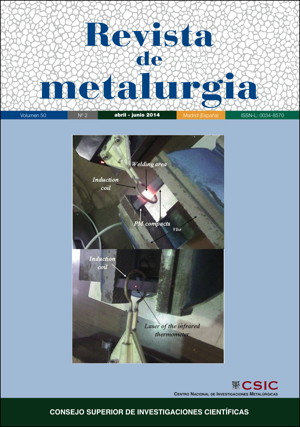Ultra high frequency induction welding of powder metal compacts
DOI:
https://doi.org/10.3989/revmetalm.016Keywords:
Iron, Powder metal compacts, Induction, Ultra high frequency induction welding, WeldingAbstract
The application of the iron based Powder Metal (PM) compacts in Ultra High Frequency Induction Welding (UHFIW) were reviewed. These PM compacts are used to produce cogs. This study investigates the methods of joining PM materials enforceability with UHFIW in the industry application. Maximum stress and maximum strain of welded PM compacts were determined by three point bending and strength tests. Microhardness and microstructure of induction welded compacts were determined.
Downloads
References
Babkib, A.S., Sharapov, S.N. (2011). Modelling the strength of the magnetic field of welding current. Welding International 25 (4), 301–304. http://dx.doi.org/10.1080/09507116.2010.540883
Balaganskii, A.Y., Ivanaiskii, V.V. (2011). Modeling the process of induction surfacing of components with a variable cross section. Welding International 25 (9), 710–714. http://dx.doi.org/10.1080/09507116.2011.566746
Çavdar, U. (2009). Identification parameters for the induction sintered iron based powder metal compacts, PhD thesis, Celal Bayar University.
Çavdar, U., Atik, E. (2008). Sintering with induction. Euro PM 2008 Conference (3), 33–38.
Çavdar, U., Atik, E. (2009). Induction sintering of Fe - 2 Cu PM compacts. Euro PM2009 Conference, 13–19.
Çavdar, U., Atik, E. (2010). Induction sintering of % 3 Cu Contented Iron Based Powder Metal Parts. Modern Applied Science 4 (3), 63–70. http://dx.doi.org/10.5539/mas.v4n3p63
Çavdar, U., Atik, E. (2014a). Investigation of conventional - and induction - sintered iron and iron-based power metal compacts. JOM, Published online.
Çavdar, U., Atik, E. (2014b). Properties of boronized, carbonitrided and steamed iron-based compacts. Materials Testing 56 (2), 126–130. http://dx.doi.org/10.3139/120.110533
German, R.M. (1994). Powder metallurgy science, 2th Edition, MPIF, USA, pp. 400–403.
German, R.M. (1996). Sintering theory and practice, A Willey INC. USA, 313–362, 373–400, 403–420.
Gruszczyk, A. (2013). New possibilities for welding and surfacing of grey iron. Welding International 27 (12), 915–919. http://dx.doi.org/10.1080/09507116.2012.708481
Haimbaugh, R.F. (2001). Practical induction heat treating, ASM International, USA, pp.3–5, 165.
Kuznetsov, M.A., Zernin, E.A. (2012). Nanotechnologies and nanomaterials in welding production. Welding International 26 (4), 23–26. http://dx.doi.org/10.1080/09507116.2011.606158
Riera, M.D., Prado, J.M. (2006). Modelling of the plasticity in cold compaction of metal powders. Rev. Metal. 42 (6), 456–462. http://dx.doi.org/10.3989/revmetalm.2006.v42.i6.43
Shulyak, A.A., Startsev, A.V., Korovin, E.M., Korolkov, P.M. (2011). Local heat treatment of large welded pressure vessels by induction heating. Welding International 25 (8), 652–655. http://dx.doi.org/10.1080/09507116.2011.566741
Wu, M.W., Tsao, L.C., Shu, G.J., Lin, B.H. (2012). The effects of alloying elements and microstructure on the impact toughness of powder metal steels. Mat. Sci. Eng. A 538, 135–144. http://dx.doi.org/10.1016/j.msea.2011.12.113
Zinn, S., Semiatin, S.L. (1988). Elements of induction heating design, control and applications, EPRI, ASM International, USA, pp. 3, 12–13.
Published
How to Cite
Issue
Section
License
Copyright (c) 2014 Consejo Superior de Investigaciones Científicas (CSIC)

This work is licensed under a Creative Commons Attribution 4.0 International License.
© CSIC. Manuscripts published in both the printed and online versions of this Journal are the property of Consejo Superior de Investigaciones Científicas, and quoting this source is a requirement for any partial or full reproduction.
All contents of this electronic edition, except where otherwise noted, are distributed under a “Creative Commons Attribution 4.0 International” (CC BY 4.0) License. You may read the basic information and the legal text of the license. The indication of the CC BY 4.0 License must be expressly stated in this way when necessary.
Self-archiving in repositories, personal webpages or similar, of any version other than the published by the Editor, is not allowed.
















